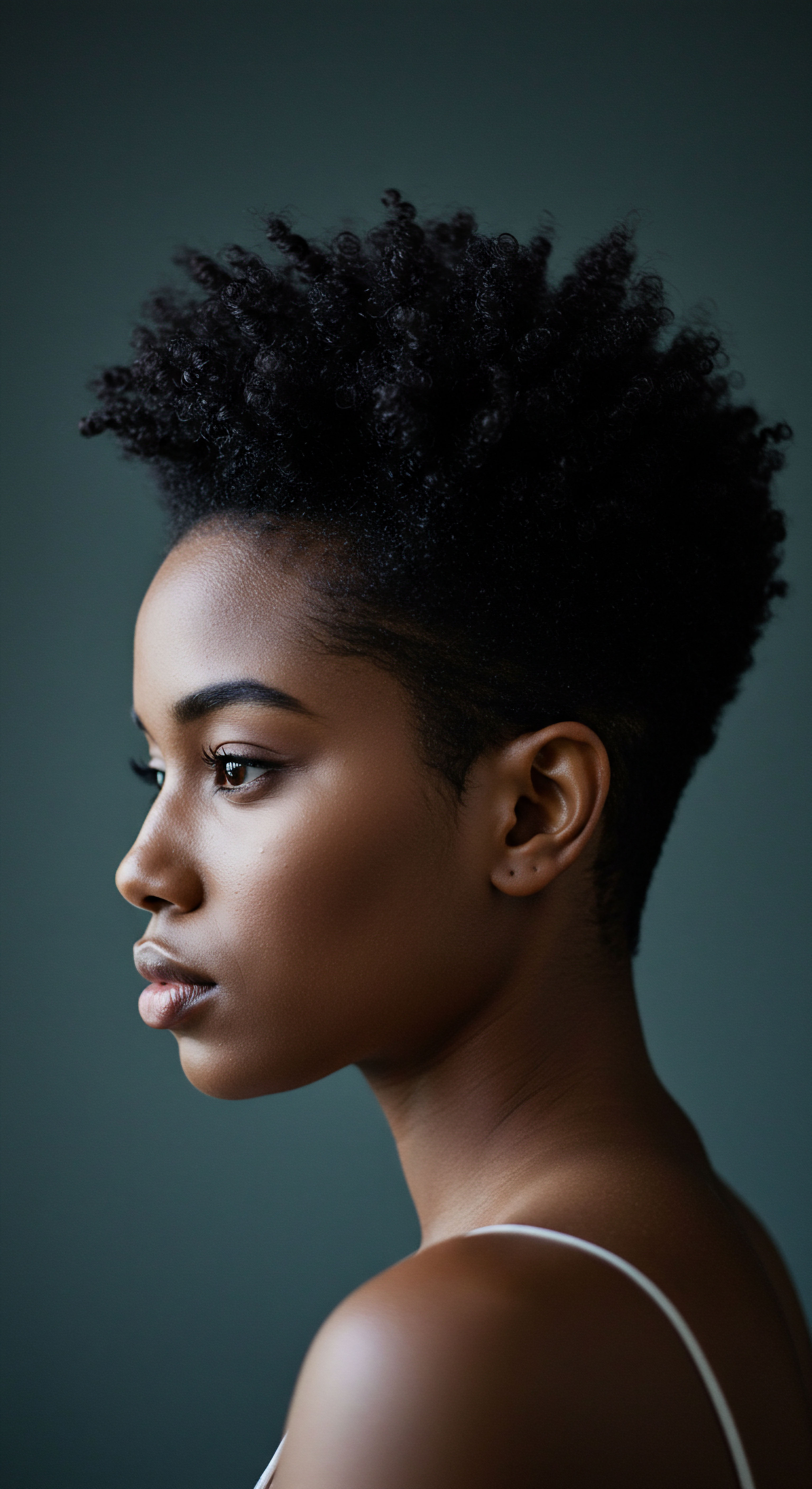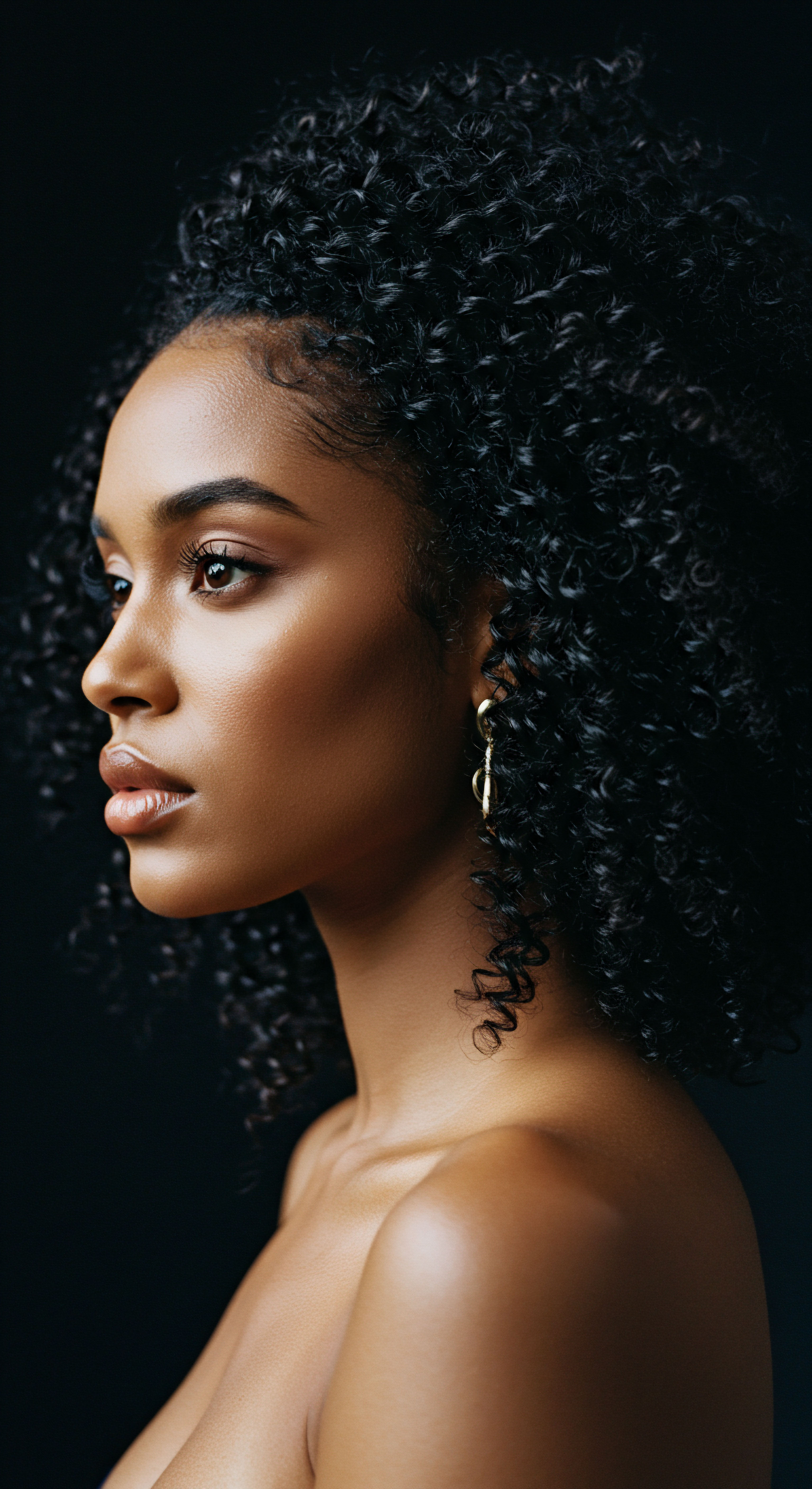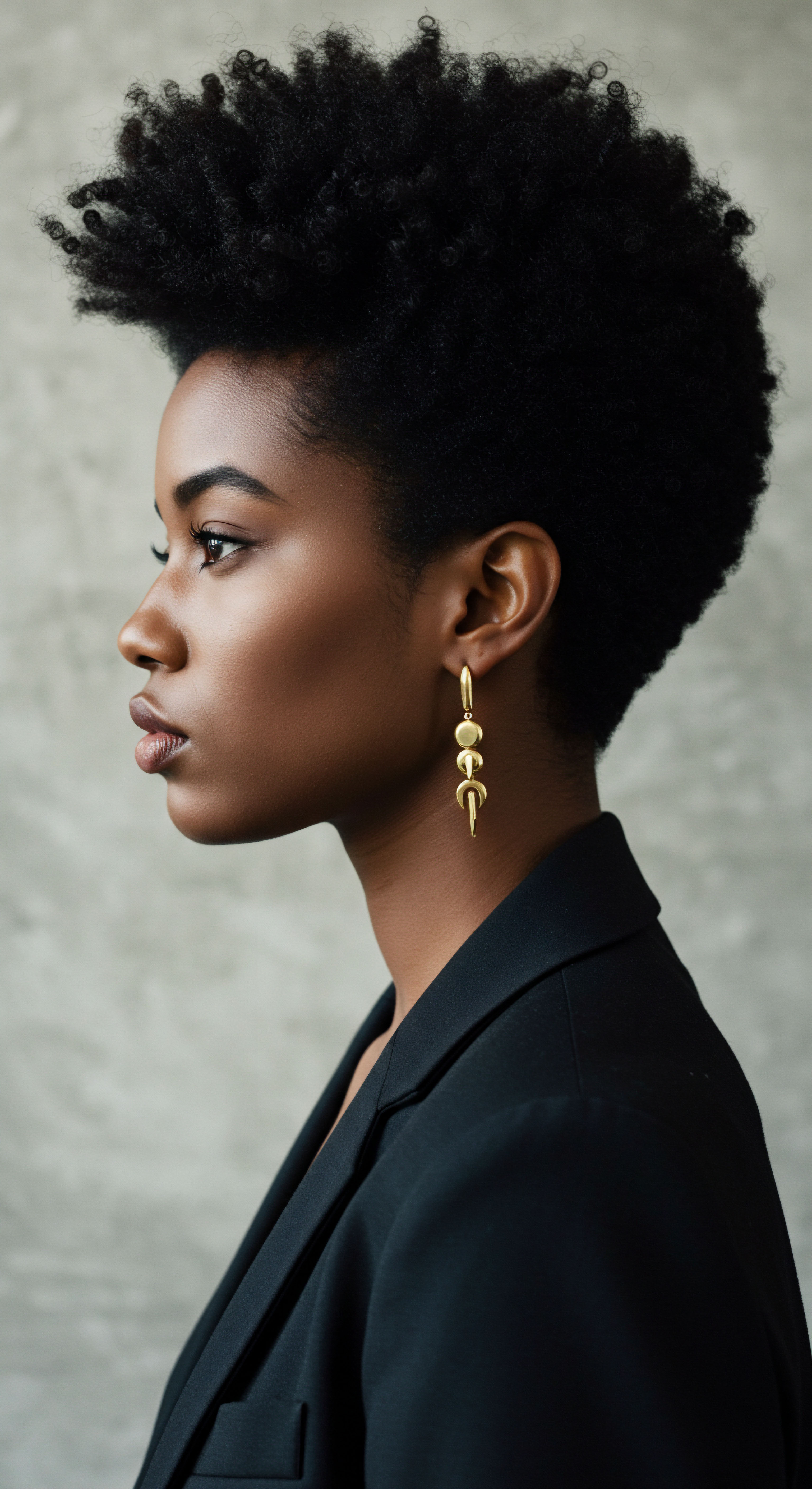
Roots
The quest for vibrant color on textured hair often begins with a deep inquiry into its very essence. Before the artistry of dye meets the canvas of curls, coils, or waves, a foundational understanding of hair’s inherent structure, particularly its porosity, becomes paramount. It is within this quiet, often overlooked, cellular architecture that the secrets to enduring color reside. This section invites us to look closely, to discern the subtle yet powerful influences that determine how color molecules interact with each individual strand, shaping not only the initial vibrancy but also its lasting presence.

What is Hair Porosity?
At its most fundamental, Hair Porosity describes the hair’s capacity to absorb and retain moisture, as well as other substances, such as hair dye. This characteristic is directly tied to the state of the hair’s outermost layer, the cuticle. The cuticle consists of overlapping, scale-like cells, much like shingles on a roof. When these scales lie flat and compact, the hair exhibits low porosity.
Conversely, when the scales are raised or compromised, the hair displays higher porosity. This structural difference has profound implications for how color takes hold and remains.
Porosity is not a static attribute. While genetics play a role, influencing the natural configuration of the cuticle, external factors significantly alter this property over time. Chemical processes, such as bleaching or relaxing, are primary culprits, causing the cuticle scales to lift and even break off, thereby increasing porosity. Heat styling, environmental exposure to UV rays or pollution, and even mechanical damage from rough handling contribute to this shift.
Hair porosity, governed by the cuticle’s state, dictates how readily strands accept and hold moisture and color.

The Microscopic World of the Hair Shaft
To truly appreciate porosity, one must peer into the microscopic realm of a single hair strand. Each strand comprises three main layers:
- Medulla ❉ The innermost core, often absent in finer hair types.
- Cortex ❉ The middle layer, making up the bulk of the hair’s mass. This is where the natural pigment, melanin, resides, and where permanent hair color changes occur. The cortex is composed of keratin proteins and structural lipids.
- Cuticle ❉ The protective outer layer, a series of dead, overlapping cells that shield the cortex from damage.
The integrity of the cuticle is the primary determinant of porosity. When the cuticle is healthy and smooth, it acts as a robust barrier, slowing down the absorption of substances. When damaged, it becomes more permeable, allowing substances to enter and exit with greater ease.
| Porosity Level Low Porosity |
| Cuticle State Tightly bound, flat |
| Moisture Absorption Resistant, slow |
| Moisture Retention High |
| Porosity Level Medium Porosity |
| Cuticle State Slightly raised, healthy |
| Moisture Absorption Balanced, good |
| Moisture Retention Good |
| Porosity Level High Porosity |
| Cuticle State Raised, compromised, gaps |
| Moisture Absorption Quick, easy |
| Moisture Retention Low, rapid loss |
| Porosity Level Understanding these states guides tailored hair care and coloring approaches. |

Why does Porosity Matter for Dye Longevity?
The interplay between hair porosity and dye longevity is a dance of chemistry and structure. Hair dye molecules, whether temporary, semi-permanent, or permanent, rely on their ability to interact with the hair shaft. For permanent dyes, this involves an alkaline agent, often ammonia, to lift the cuticle and allow dye precursors to penetrate the cortex, where they react and expand into larger, color-forming molecules too large to easily escape. Semi-permanent dyes, by contrast, typically deposit color onto the surface or slightly within the cuticle without fundamentally altering the natural pigment.
A hair strand with low porosity, possessing a tightly sealed cuticle, resists the initial penetration of dye molecules. This can lead to less vibrant color outcomes or require longer processing times and stronger developers to achieve the desired shade. Yet, once the color does settle, the tightly bound cuticle acts as a steadfast guard, making it more difficult for the pigment to escape, thus contributing to longer color retention.
In stark contrast, highly porous hair, with its lifted and damaged cuticle, readily absorbs dye. This quick absorption can sometimes lead to an over-absorption of pigment, resulting in darker or duller initial color than intended. The significant challenge with high porosity hair, however, lies in its inability to hold onto the color.
The open cuticle scales allow dye molecules to leak out rapidly, leading to accelerated fading. This swift departure of color is a common lament for those with highly porous textured hair.

Ritual
Moving beyond the foundational understanding of hair’s structure, we arrive at the practical realm of hair care, where daily rituals and conscious choices shape the longevity of hair color on textured strands. The application of dye is but one moment in a continuous journey of care, and how we attend to our hair before, during, and after coloring significantly influences the vibrancy and staying power of our chosen hue. This section delves into the actionable wisdom that empowers us to nurture our colored hair, ensuring its beauty persists through the ebb and flow of life.

How Does Pre-Color Preparation Affect Dye Adherence?
The canvas must be prepared with thoughtful intention before the artist begins their work. For textured hair, this preparation is particularly meaningful. A key aspect of this readiness involves balancing the hair’s porosity. For those with naturally lower porosity, creating a slightly more receptive environment for the dye can be beneficial.
Gentle clarifying shampoos, used sparingly a few days prior to coloring, can help remove product buildup that might otherwise hinder dye penetration. Applying heat, such as a warm rinse or a gentle steam treatment, can also help to subtly lift the cuticle, making the hair more amenable to color absorption.
Conversely, for hair already exhibiting higher porosity, the preparation shifts towards reinforcement. Protein treatments or pre-color treatments can temporarily fill the gaps within the lifted cuticle layers, creating a smoother, more even surface for the dye to adhere to. This pre-treatment helps to prevent uneven color absorption and reduces the likelihood of rapid fading.
Thoughtful pre-coloring routines, tailored to porosity, lay the groundwork for enduring color.

What Role Does PH Play in Color Retention?
The delicate balance of pH is a silent architect of color longevity. Natural, healthy hair maintains a slightly acidic pH, typically between 4.5 and 5.5. This acidic environment keeps the cuticle scales lying flat and closed, acting as a protective seal that locks in moisture and pigment.
Hair dyes, particularly permanent ones, are formulated with alkaline agents like ammonia, which raise the hair’s pH (often to 9-11) to swell and lift the cuticle, allowing dye molecules to enter the cortex. While this lifting is essential for color deposition, maintaining a high pH after coloring can leave the cuticle open and vulnerable, leading to moisture loss and accelerated color fading.
This understanding underscores the significance of post-coloring care products. Using acidic or pH-balancing shampoos and conditioners helps to gently lower the hair’s pH, encouraging the cuticle to lie flat once more. This sealing action is crucial for trapping the newly deposited color molecules within the hair shaft, prolonging their vibrancy and preventing premature wash-out.

How Do Different Dye Types Interact with Porosity?
The type of dye chosen also dances in concert with hair porosity, influencing the ultimate color experience.
- Temporary Dyes ❉ These dyes coat the outer layer of the hair shaft without penetrating the cuticle. On low porosity hair, they might struggle to adhere evenly, potentially appearing less vibrant. On high porosity hair, they can sometimes absorb more deeply than expected, leading to a more intense initial shade, but they will still wash out quickly as the compromised cuticle cannot hold them.
- Semi-Permanent Dyes ❉ These dyes deposit color molecules onto the hair’s surface or slightly into the cuticle without altering natural pigment. For low porosity hair, penetration can be challenging, requiring longer processing times or even gentle heat to encourage absorption. For high porosity hair, semi-permanent dyes are absorbed readily, but the open cuticle allows for swift color leakage and fading with each wash.
- Permanent Dyes ❉ These dyes involve a chemical reaction that opens the cuticle and deposits color deep within the cortex. Low porosity hair might resist initial penetration, demanding stronger developers or extended processing. However, once the color is set, the tightly sealed cuticle helps retain the pigment effectively. High porosity hair readily accepts permanent dye, but its compromised structure means the color molecules, despite their larger size after oxidation, can still leach out more quickly than from less porous strands.
A study examining dye absorption and fading across different porosity levels found that medium and high porosity hair retained dye better than low porosity hair initially, but high porosity hair faded faster, especially with semi-permanent and temporary dyes. Intriguingly, the study noted that high porosity hair sometimes held onto temporary dye longer due to deeper absorption, a counterintuitive finding that points to the complexities of dye interaction with varying hair structures. This highlights that even with temporary solutions, porosity remains a central character in the story of color retention.

Relay
As we delve deeper into the intricate interplay between hair porosity and dye longevity, we move beyond the immediate actions of care to consider the broader, more subtle influences that shape this relationship. This section offers a more profound understanding, drawing connections between the intrinsic characteristics of textured hair, the subtle degradation pathways of color, and the cultural contexts that inform our hair journeys. It is here that science and lived experience truly converge, painting a fuller picture of how color endures, or gently fades, on our unique strands.

How Does the Unique Structure of Textured Hair Affect Porosity and Dye?
Textured hair, encompassing the beautiful spectrum of waves, curls, and coils, possesses distinct structural characteristics that influence its porosity and, by extension, its interaction with dye. Unlike straight hair, which typically has a more uniform, round cross-section, textured hair often exhibits an elliptical or flattened cross-sectional shape and a more varied diameter along its length. This inherent architectural complexity means the cuticle layers, though similar in composition, may not lie as uniformly flat as on straight hair, even in an untreated state.
African hair, for instance, often has a higher density of disulfide bonds and can exhibit the lowest radial swelling in water due to its unique lipid levels. While some textured hair can be naturally low porosity, many textured hair types are predisposed to higher porosity due to their natural curl patterns and the potential for cuticle lifting at the curves and bends of the strand. This natural tendency towards a more open cuticle, even before chemical processing, means that dye molecules might penetrate more readily but also escape with greater ease.
Consider the impact of Melanin, the natural pigment that gives hair its color. Textured hair, particularly hair of African descent, often contains a higher concentration of eumelanin, which provides darker brown and black hues. While melanin itself does not directly dictate porosity, its presence means that to achieve lighter or more vibrant colors, a more aggressive lightening process is often required, which inherently increases hair porosity. This delicate balance between lightening the natural pigment and preserving the hair’s structural integrity is a constant consideration for colorists working with textured hair.

What are the Chemical and Environmental Culprits Behind Color Fading?
Beyond the initial porosity, a host of chemical and environmental factors continuously challenge the longevity of hair dye. These elements wage a subtle, ongoing war against the vibrant hues we seek to maintain.
- Oxidative Stress ❉ Hair dyeing, especially permanent coloring, involves oxidative processes. Hydrogen peroxide, a common developer, oxidizes natural melanin and dye precursors to form larger color molecules within the cortex. However, this process also generates reactive oxygen species (ROS) that can lead to oxidative stress. This stress continues post-coloring, caused by exposure to UV light, heat, and even air and water. Oxidative stress can degrade both natural melanin and artificial dye molecules, causing them to break down and fade. Research indicates that oxidative hair dyes and melanin degrade through similar pathways ❉ their chromophores progressively break down, shifting visible hues from cool to red, then to yellow.
- PH Imbalance ❉ As discussed, alkaline dye formulations open the cuticle. If the hair’s pH is not adequately rebalanced and the cuticle resealed after coloring, the hair remains in a vulnerable, porous state. Even daily routines, like washing with shampoos that have a high pH (above 6), can cause the cuticle to lift, allowing color to leach out.
- Water Quality and Washing Habits ❉ The water we use for cleansing can impact color. Hard water, with its mineral content, and water with a higher pH can contribute to cuticle lifting and color fading. Frequent washing, regardless of water type, naturally contributes to color loss as dye molecules are rinsed away, particularly with semi-permanent dyes that primarily coat the hair shaft.
- Heat and Mechanical Damage ❉ High heat from styling tools and vigorous mechanical manipulation (like aggressive brushing or towel drying) can further compromise the cuticle, increasing porosity and accelerating color fade. A study on textured hair found that routine practices involving washing, blow-drying, and flat ironing significantly affected hair porosity, leading to structural alterations and reduced ability to absorb cationic dye.

Can Porosity Be Managed for Better Color Longevity?
The good news is that porosity, while influenced by inherent hair characteristics and past treatments, can be strategically managed to significantly improve dye longevity. This management involves a multi-pronged approach that respects the hair’s unique needs.
For Low Porosity Hair, the strategy centers on encouraging absorption.
- Warmth ❉ Applying warm water before conditioning or treatments helps to gently lift the tightly bound cuticle, allowing products and color to penetrate more effectively.
- Lightweight Products ❉ Choosing products with smaller molecular structures, such as certain oils (coconut, jojoba) or humectants (glycerin, panthenol), can aid penetration without weighing the hair down or causing buildup.
- Extended Processing ❉ When coloring, allowing the dye to sit for the full recommended time, or even slightly longer (following professional guidance), can help ensure adequate pigment deposition.
For High Porosity Hair, the focus shifts to sealing and strengthening.
- Protein Treatments ❉ Regular protein treatments can help fill in the gaps and strengthen the compromised cuticle, providing a more stable surface for color adherence. This is especially relevant for chemically damaged textured hair.
- Acidic Rinses and Products ❉ Using products with a slightly acidic pH helps to flatten and seal the cuticle after coloring and washing, locking in moisture and color. Cold water rinses after conditioning also serve this purpose.
- Layering and Sealing ❉ Applying leave-in conditioners and then sealing with a lightweight oil can help create a protective barrier that slows moisture and color loss.
- Minimizing Damage ❉ Reducing exposure to excessive heat styling, harsh chemicals, and vigorous manipulation helps prevent further cuticle damage, which is paramount for color retention.
A nuanced approach, recognizing that hair can have varying porosity levels across different sections, is often most effective. For instance, a single head of hair might have low porosity near the roots (new growth) and high porosity at the ends (older, more treated hair). Tailoring product application and care to these localized needs ensures a more harmonious and enduring color result. The goal is always to work with the hair’s intrinsic nature, not against it, to unveil its most radiant and lasting beauty.

Reflection
The journey through hair porosity and dye longevity on textured strands reveals a landscape rich with scientific wonder and personal resonance. It speaks to the profound connection between our biological makeup and the stories we tell with our appearance. Understanding these intricate relationships allows us to move beyond mere surface-level solutions, inviting a deeper, more respectful engagement with our hair.
Each strand, with its unique porosity, carries a history of care, environment, and personal expression. As we consider the delicate balance required for color to truly settle and stay, we are reminded that true vibrancy comes not from fighting against our hair’s nature, but from listening to its whispers and providing the nourishment it truly seeks.

References
- Perez, L. M. et al. (2022). Porosity and Resistance of Textured Hair ❉ Assessing Chemical and Physical Damage Under Consumer-Relevant Conditions. MDPI.
- Draelos, Z. D. (2011). Hair Cosmetics ❉ An Overview. Journal of Cosmetic Dermatology, 10(1), 3-13.
- Robbins, C. R. (2012). Chemical and Physical Behavior of Human Hair. Springer Science & Business Media.
- Gavazzoni Dias, M. F. R. (2015). Hair Cosmetics ❉ An Overview. International Journal of Trichology, 7(1), 2-15.
- Feughelman, M. (1997). Mechanical Properties of Keratin Fibers. Journal of the Society of Cosmetic Chemists, 48(4), 195-209.
- DeBerard, R. (2025). The Analogous Degradation Pathways of Oxidative Hair Dyes and Melanin ❉ An Analysis of Conjugated Bonds, Hair Color, and How it Lightens. ChemRxiv.
- Morel, C. et al. (2020). Porosity at Different Structural Levels in Human and Yak Belly Hair and Its Effect on Hair Dyeing. Molecules, 25(9), 2191.
- Saddiq, R. (2020). Morphological properties of hair and their variation when subjected to oxidation via chemical bleaching. University of Huddersfield.
- Chandrashekara, M. N. et al. (2017). Diffusion Characteristics of Solutes in Hair Using Positron Annihilation Lifetime Spectroscopy. Journal of Cosmetic Science, 68(2), 157-168.
- Pérez-Carrillo, L. A. et al. (2023). Advances in Permeation of Solutes into Hair ❉ Influencing Factors and Theoretical Models. Cosmetics, 10(2), 52.
- Marsh, J. M. et al. (2020). An Overview on Hair Porosity. NYSCC.
- Guo, J. et al. (2018). The Impact of pH on Hair Health. Journal of Cosmetic Science, 69(3), 207-217.
- De Berard, R. (2025). The Analogous Degradation Pathways of Oxidative Hair Dyes and Melanin ❉ An Analysis of Conjugated Bonds, Hair Color, and How it Lightens. ChemRxiv.